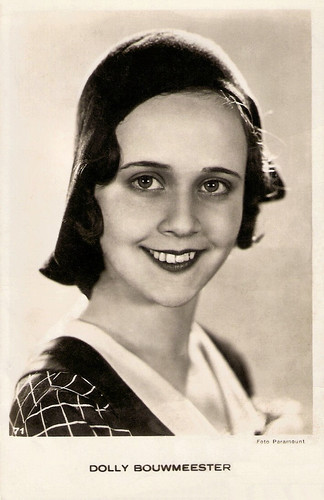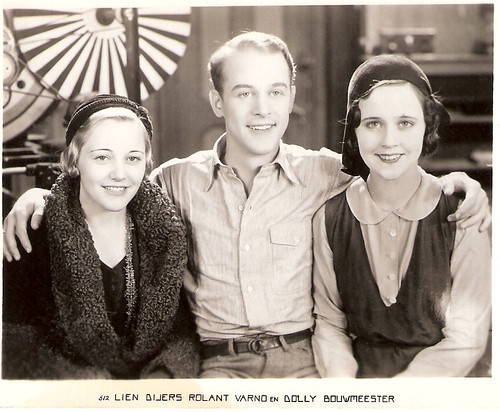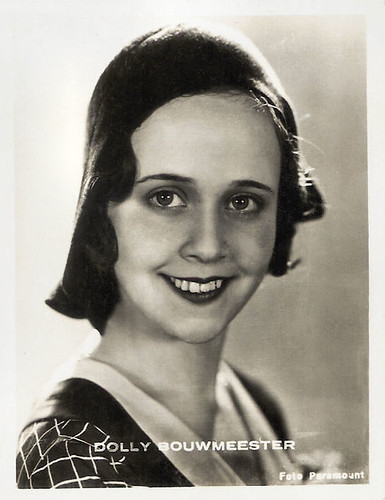
Dutch Postcard, no. 71, 1931. Photo: Paramount.
Early Dutch sound films
Dolly Bouwmeester was born in 1913 in The Hague, Netherlands. She was the daughter of violinist Louis Adolf Bouwmeester and the Belgian pianist Julie Arpeau dit Du Rosay. She was the younger sister of Dutch film diva Lily Bouwmeester and the twin sister of dancer and mime artist Louis 'Loutje' Bouwmeester.
As a young girl, she started her career as a stage actress in 1927. She debuted at the age of fourteen at the Hofstad Theatre in Rotterdam in the comedy 'Het premielot' (The premium lottery ticket), in which she played a boy. In the following years, she worked with Cor Ruys for the Dutch East Indies Theatre, where she mainly acted in comedies. Then she worked for the theatre company of Cor van der Lugt Melsert.
She starred in three early Dutch sound films. First, she was engaged for the Dutch experimental sound film Finale/Final (Gerard Rutten, 1931) in which Adolphe Engers starred as a demonic mortician. The film was never finished because of financial problems and now only some footage remains. That same year, Dolly went to the Paramount Studios in France for another experimental sound film, De sensatie der toekomst/The Sensation of the Future (Victor Buchowetzki, Jack Salvatori, 1931).
She continued her stage career in September 1931 with the theatre company of Louis Davids and played with him and Corry Vonk in the play 'In 't witte paard' (The White Horse Inn). Four years later, Bouwmeester travelled to Berlin to play the title role in the film Fientje Peters - poste restante (Victor Janson, 1935) with Herman Tholen and Louis Borel. It was the alternate-language version of the German film Hilde Petersen postlagernd/Hilde Petersen: General Delivery (Victor Janson, 1936).
None of her films were successful. In 1935 she married Brit John Jackson and emigrated to London. There she acted in one more film The Jack of Diamonds (Vernon Sewell, 1949) with Nigel Patrick, who also co-wrote the screenplay. The low-budget thriller was made by Vernon Sewell's own production company. After the death of her husband, Dolly Bouwmeester returned to the Netherlands. She died in 1986 in Leiden, The Netherlands, at the age of 73.

Lien Deyers, Roland Varno & Dolly Bouwmeester. Dutch Postcard, no. 512. Photo: Paramount. Publicity still for De sensatie der toekomst (1931).
The sensation of the future
The postcards above were both produced for the Science Fiction detective film De sensatie der toekomst/The Sensation of the Future (also known as Televisie/Television) about the new phenomenon of television - the 'sensation of the future'.
At the time of her film debut, Dolly was only 18 years old. Her co-star was the young Dutch actor Roland Varno, who already had acted in German films. Lien Deyers who is also pictured in the postcard above was merely visiting the Paramount studios.
De sensatie der toekomst was a Dutch version of the American-French production Magie Moderne (Dimitri Buchowetzki, 1931), filmed in Les Studios Paramount in Joinville-le-pont, a commune in the southeastern suburbs of Paris, France. On the same set versions for Italy, Romania, Czechoslovakia and Sweden were made with different actors.
The television scenes, including fragments with Bedouins and Rif Kabyles in Morocco, and Clara Bow romping on a New York beach, were for all alternative language versions the same.
Although Paramount finished De sensatie der toekomst/The Sensation of the Future in February 1931, the studio did not release the film in Dutch cinemas until October. The reviews were lukewarm. The first Dutch sound feature was soon forgotten and nowadays it is assumed to be lost.

Small German collectors card. Photo: Paramount. Publicity still for De sensatie der toekomst/Television (1931).
Sources: Simon Koster (De Bouwmeesters - Dutch), Gerard Rutten (Mijn papieren camera - Dutch), Eric Winter (Weekblad Cinema en Theater @ Virtual History - Dutch), Filmtotaal (Dutch), Wikipedia (Dutch) and IMDb.
This post was last updated on 24 July 2023.
No comments:
Post a Comment